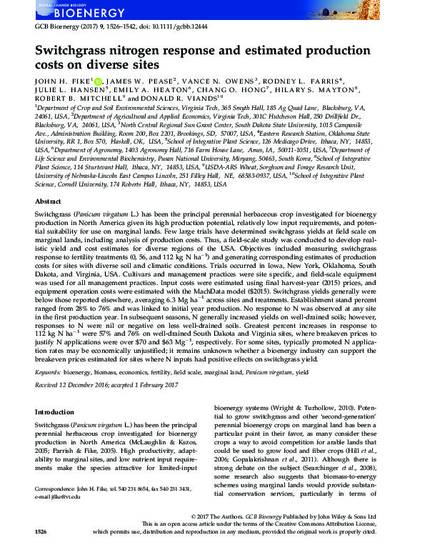
Switchgrass (Panicum virgatum L.) has been the principal perennial herbaceous crop investigated for bioenergy production in North America given its high production potential, relatively low input requirements, and potential suitability for use on marginal lands. Few large trials have determined switchgrass yields at field scale on marginal lands, including analysis of production costs. Thus, a field-scale study was conducted to develop realistic yield and cost estimates for diverse regions of the USA. Objectives included measuring switchgrass response to fertility treatments (0, 56, and 112 kg N ha−1) and generating corresponding estimates of production costs for sites with diverse soil and climatic conditions. Trials occurred in Iowa, New York, Oklahoma, South Dakota, and Virginia, USA. Cultivars and management practices were site specific, and field-scale equipment was used for all management practices. Input costs were estimated using final harvest-year (2015) prices, and equipment operation costs were estimated with the MachData model ($2015). Switchgrass yields generally were below those reported elsewhere, averaging 6.3 Mg ha−1 across sites and treatments. Establishment stand percent ranged from 28% to 76% and was linked to initial year production. No response to N was observed at any site in the first production year. In subsequent seasons, N generally increased yields on well-drained soils; however, responses to N were nil or negative on less well-drained soils. Greatest percent increases in response to 112 kg N ha−1 were 57% and 76% on well-drained South Dakota and Virginia sites, where breakeven prices to justify N applications were over $70 and $63 Mg−1, respectively. For some sites, typically promoted N application rates may be economically unjustified; it remains unknown whether a bioenergy industry can support the breakeven prices estimated for sites where N inputs had positive effects on switchgrass yield.
Available at: http://works.bepress.com/emily-heaton/51/

This article is published as Fike, J. H., Pease, J. W., Owens, V. N., Farris, R. L., Hansen, J. L., Heaton, E. A., Hong, C. O., Mayton, H. S., Mitchell, R. B. and Viands, D. R. (2017), Switchgrass nitrogen response and estimated production costs on diverse sites. GCB Bioenergy, 9: 1526–1542. doi:10.1111/gcbb.12444.